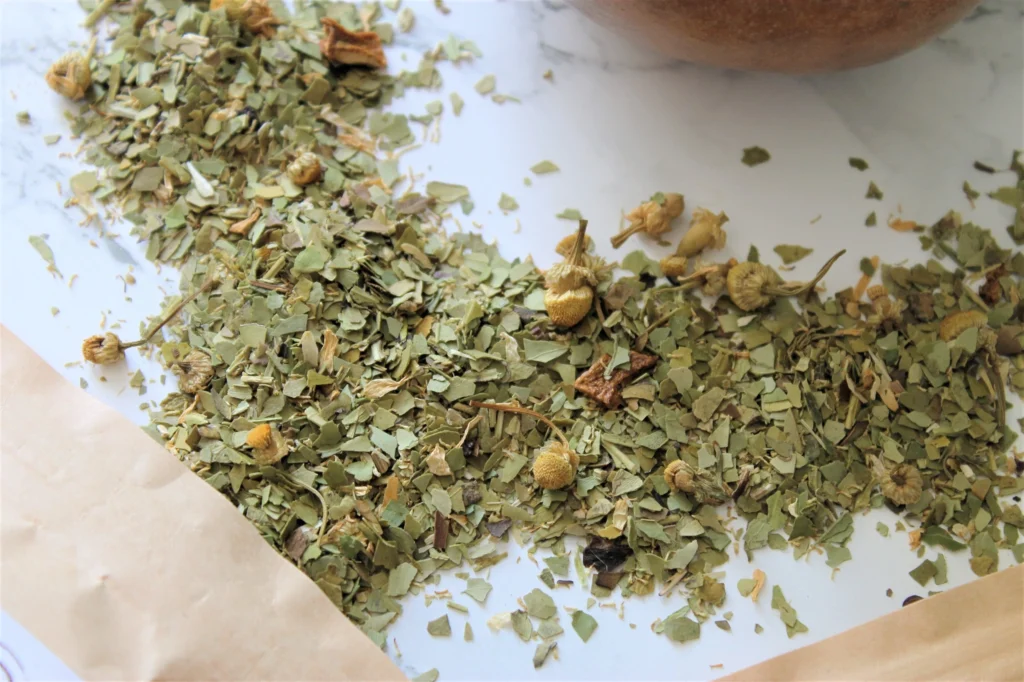A tea bath is exactly what it sounds like – putting tea in your bath! After all, we soak ourselves in salts, essential oils, and various bath bombs, bubble solutions, and shower gels, so why not tea too? A tea bath blend can contain all kinds of various herbs that have different benefits for your skin. But those benefits might not be the same as the benefits you’d get from drinking tea.
The benefits you’ll get from a tea bath are through aromatherapy (the hot steam from your bath) or through topical application (soaking into your skin). For example, drinking a cup of mint tea can be great for digestion, but applying mint tea topically via a bath is better for treating tension headaches.
Here are three reasons why I love to take a tea bath.
1. Relaxing Aromatherapy
Aromatherapy is all about breathing in the aromas of certain materials for relaxing benefits. Some common aromatherapy ingredients include lavender, chamomile, eucalyptus, and tea tree. When you put these herbal ingredients in your bath, the hot water will “brew” them and release their delicious aroma in the steam of your bath.
Putting essential oils directly into your bath (particularly lavender and tea tree) can irritate your skin. But the beauty of using tea is that you’re not getting the concentrated oils. Instead, you are getting a more diluted infusion that comes from simply soaking the dried ingredients in hot water. Of course, if you feel an irritation you should get out of the tub immediately and gently wash your skin with lukewarm water.
If you are interested in the aromatherapy benefits of taking a tea bath, you might like this Solar Bath Tea by Purple Canyon. It contains eucalyptus, peppermint and calendula for a refreshing and bright scent. It’s ideal for revitalising your skin after a day in the sun.
2. Use Up Old Tea
Taking a tea bath is a great way to use up old tea that’s no longer good for drinking. This might include a plain sencha green tea that’s gone stale, or a herbal tea blend that you just don’t like the flavour of. Only certain teas are suitable for a bath: herbal teas that are free of added flavourings and colourings, plus teas that don’t contain any ingredients that might irritate your skin or trigger your allergies.
Black tea is high in tannins, so there’s a theory that it can cleanse and close your pores. Green tea, on the other hand, is loaded with antioxidants so you might see claims that it has anti-aging properties. Some herbal teas are popular for a bath blend simply because they smell nice, like orange blossom and rose.
Three teas I like to use for a tea bath include:
- Dragonfly Tea Moonlight Jasmine – soft green tea with a gentle jasmine scent.
- Tea People Hojicha – a warming, woody and nutty scent. This Japanese tea is worth exploring if it’s new to you!
- Hampstead Lavender Valerian Tea – if you have run out of sleep bath salts, this tea is a great alternative. The lavender and valerian scents are super soothing.
3. Reducing Inflammation
I tend to take purported “health benefits” with a generous pinch of bath salts. Just because a study conducted halfway across the world on five people had promising results doesn’t necessarily mean you’ll feel the health benefits at home too.
Nonetheless, one of the most studied impacts of applying herbal ingredients topically is how it can increase or reduce inflammation. If your skin is broken with cuts and scrapes, or you have a severe allergic reaction, you should seek medical attention. However, for less serious skin inflammation cases (like dry skin or light sun burn) a tea bath could be a good home remedy. Just like an oatmeal bath!
Will tea miraculously heal you? No, probably not. But you can give it a try nonetheless. Tea ingredients with potential anti-inflammatory ingredients include:
- Calendula
- Linden flowers
- Thyme
- Rose
- Peppermint
- Chamomile (see my list of best chamomile teas)

How to Take a Tea Bath
Taking a tea bath is super simple. You can either buy a pre-made bath blend (if you’re in the UK, Not On The High Street has some vibrant options) or use your own tea.
- Run your bath with hot water to a temperature that feels comfortable for you,
- Dunk in around five teabags and let them soak until the bath smells aromatic – this might be a few minutes or significantly longer, depending on the freshness of the teabags and the exact tea type you are using,
- Remove the teabags if you want, or just get in alongside them!
- Optional: rinse off with warm water after your bath, if you don’t like the feel of it on your skin.
A note on loose leaf tea: it may look pretty to have whole chamomile flowers floating in your tub, but it won’t be so much fun when they float right up you-know-where. So, if using loose leaf, try to strain them out or use a metal tea infuser so they can be easily removed before you hop in.
If you have tried a tea bath, I’d love to hear your thoughts in the comments below.
